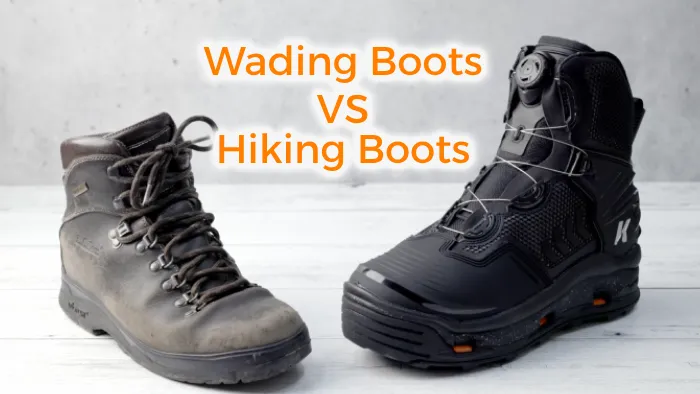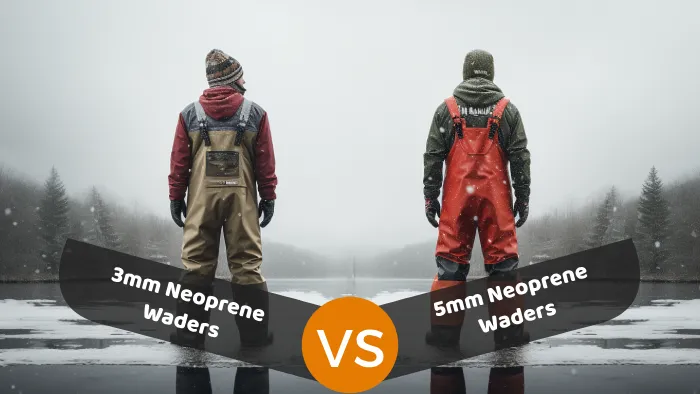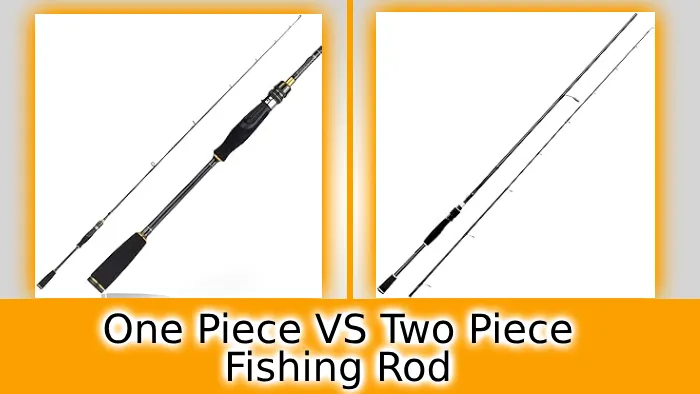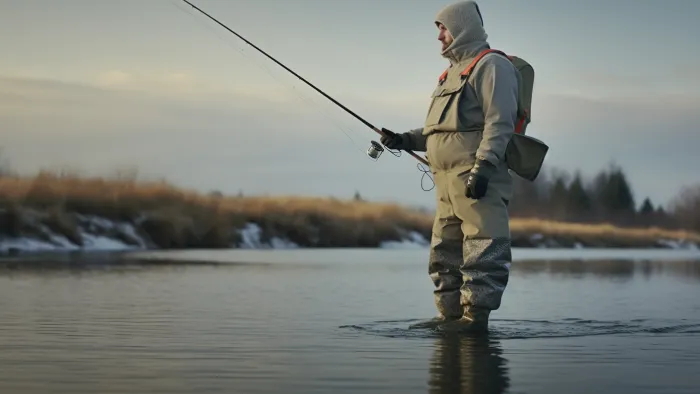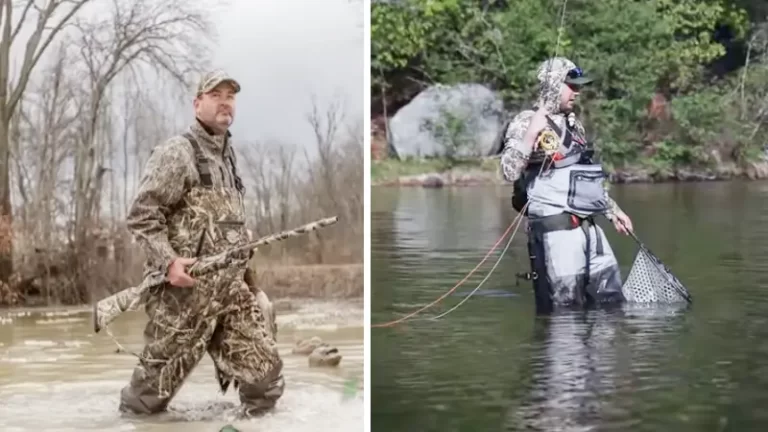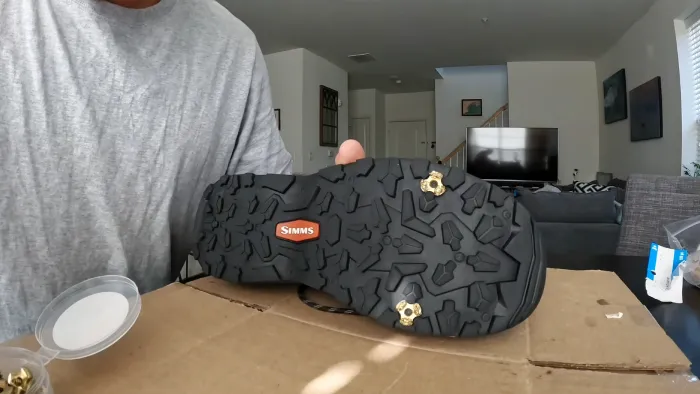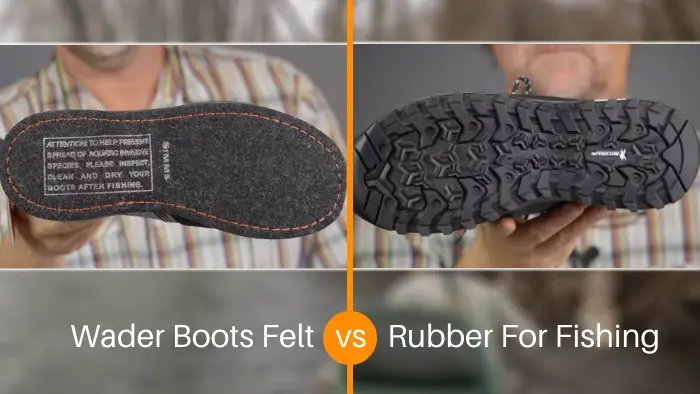Wading Boots vs Hiking Boots for Fishing: Ten Significant Differences
Are you an avid adventurer searching for the perfect footwear to conquer both land and water? Do you need to choose between wading boots and hiking boots? While both options have benefits and drawbacks, there are significant differences between them.
Wading boots, designed explicitly for water activities like fishing and river crossings, offer unrivaled traction and protection in slippery conditions. Alternatively, hiking boots are built for conquering rugged terrains and providing ankle support during long hikes.
Today, we will discuss wading and hiking boots, comparing their features and functionality to help you make an informed decision. So, let’s take a closer look at the major differences between wading boots and hiking boots.
The Significant Differences Between Wading Boots and Hiking Boots
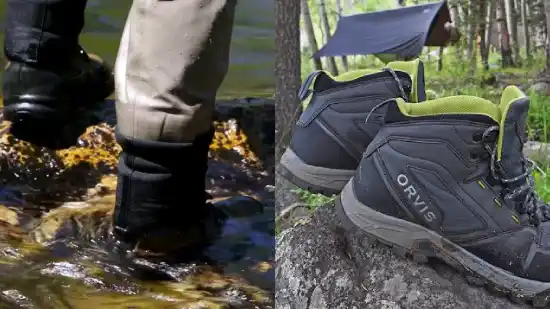
There are several significant differences to consider when comparing wading boots and hiking boots. But firstly, the material and construction of these boots vary greatly.
- Material and construction
- Durability and environment
- Fit and comfort
- Lining and breathability
- Protection and foot support
- Warmth and water resistance
- Purpose and activities
- Traction and grip
- Ankle support and stability
Let’s discuss these differences in detail:
Material and Construction
As you slip on your wading boots, you can feel the sturdy vulcanized rubber hugging your feet, ready to conquer any watery obstacle that comes your way.
Wading boots are typically made of vulcanized rubber or PVC, highly resistant to water exposure. This ensures your feet stay dry and protected, even in the most challenging aquatic environments.
In contrast, hiking boots are primarily made of leather or synthetic materials, which offer durability and support on rugged terrain. These materials are designed to withstand the rigors of hiking, providing excellent traction and stability.
The construction of wading boots and hiking boots also differs. Wading boots often feature reinforced toe caps and ankle support for added protection against rocks and other hazards in the water.
Conversely, hiking boots have a more flexible construction, allowing for natural foot movement while providing ample ankle support.
Durability and Environment
You’ll love how durable and environmentally friendly these boots are. Wading boots are designed to withstand wet and muddy environments, making them the perfect choice for fishing or walking through streams.
Alternative to that, hiking boots are made to withstand tough terrain and may not be ideal for wet or muddy environments.
Fit and Comfort
When looking for fit and comfort, hiking boots take the lead. They are designed with cushioning and support in mind, prioritizing your comfort on long hikes.
With added padding, hiking boots offer a more cushioned feel, making them suitable for various terrains.
In contrast, wading boots prioritize a snug fit to prevent slipping in the water. While they may not be as comfortable as hiking boots, they are more suitable for water activities such as fishing or crossing streams. Remember that wading boots are not meant for long hikes or extended periods of walking.
Lining and Breathability
Wading and hiking boots have distinct differences when considering lining and breathability. Wading boots may have waterproofing, but they often lack breathability, causing your feet to feel sweaty and uncomfortable.
On the other hand, hiking boots are designed to be waterproof while featuring breathable materials. This means that your feet will stay dry and comfortable even if you encounter water during your hike.
The lining of hiking boots is designed to wick away moisture, preventing sweat buildup. Also, these boots often have mesh panels or perforations that allow air to circulate, keeping your feet cool and dry.
Protection and Foot Support
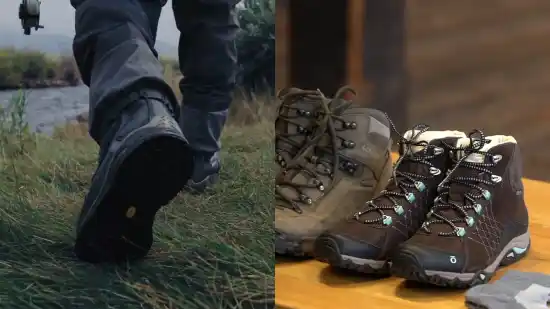
With their sturdy construction and reinforced ankle support, hiking boots cradle your feet and provide the ultimate protection on rugged terrain. Unlike wading boots, hiking boots are designed to endure the toughest conditions while keeping your feet safe and secure.
The robust materials used in hiking boots, such as leather or synthetic uppers, provide excellent resistance against sharp objects and rough terrain. Also, these boots often feature a toe cap or bumper, safeguarding your feet from accidental impacts.
The superior foot and ankle support offered by hiking boots help prevent sprains and injuries, ensuring stability and comfort throughout outdoor adventures. The table below summarizes the key differences between wading boots and hiking boots:
| Wading Boots | Hiking Boots | |
| Water exposure | May not protect feet from all water exposure | Provide more protection against water exposure |
| Ankle support | Offer minimal ankle support | Provide reinforced ankle support |
| Terrain suitability | Not ideal for rough terrain | Designed for rugged terrain and unpredictable conditions |
Warmth and Water Resistance
When you slip on a pair of hiking boots, your feet will be wrapped in a cozy embrace, like being nestled in a warm blanket on a cold winter’s night.
While wading boots are designed to keep feet warm in the water, hiking boots prioritize water resistance and breathability without extra insulation. This means that hiking boots may not provide the same warmth as wading boots.
However, hiking boots are still designed to offer protection and warmth, especially in wet conditions. They are typically made with water-resistant materials and feature cushioned insoles to provide comfort and support.
While they may not keep your feet as warm as wading boots, they are a great option for hiking in wet environments where insulation is not a top priority.
Purpose and Activities
For outdoor enthusiasts, the activities and purposes for each type of footwear greatly differ.
Wading boots are specifically designed for water activities such as fishing, hunting, and walking. They provide excellent traction on slippery surfaces and are made with materials that are resistant to water, ensuring your feet stay dry and comfortable.
In contrast, hiking boots are primarily designed for hiking on rugged terrains but can also be used for other activities. They offer sturdy support, ankle stability, and protection against rough terrain, rocks, and branches.
Traction and Grip
Wading boots offer unparalleled traction and grip on wet surfaces, ensuring stability and confidence during water activities. The felt soles of wading boots are specifically designed to provide excellent traction in the water.
The fibers of the felt sole absorbs water, creating a gripping surface that effectively prevents slipping on wet rocks, moss, and other slippery surfaces found in rivers and streams. This unique feature allows anglers and enthusiasts to navigate through water, confidently maintaining balance and stability.
Conversely, hiking boots are designed for different terrains and offer the best traction and grip on dirt, rocks, and uneven trails. Their sturdy soles, often made with rubber or Vibram, provide excellent traction and prevent slips and falls in challenging hiking conditions.
Ankle Support and Stability
With their focus on ankle support and stability, hiking boots are designed to provide confidence and stability on rugged and uneven terrain.
Compared to wading boots, hiking boots offer superior ankle support due to their higher cut and stiffer construction. This feature helps prevent ankle sprains and offers better protection against twisted ankles.
Also, hiking boots often feature reinforced toe caps and heel counters, providing extra stability and preventing injuries in challenging terrains.
Comparison Table Between Wading Boots and Hiking Boots
| Aspect | Wading Boots | Hiking Boots |
| Material | Vulcanized rubber or PVC | Leather or synthetic materials |
| Construction | Reinforced toe caps and ankle support | Flexible construction with ankle support |
| Durability | Designed to withstand wet and muddy environments | Made to withstand tough terrains |
| Fit and Comfort | Snug fit for water activities, less comfortable for long hikes | Cushioning and support for long hikes |
| Lining and Breathability | Lack breathability, may cause sweaty feet | Waterproof and breathable materials, moisture-wicking lining |
| Warmth and Water Resistance | Designed to keep feet warm in water | Water-resistant with cushioned insoles |
| Purpose and Activities | Specifically for water activities such as fishing and walking | Primarily for hiking, but can be used for other activities |
| Traction and Grip | Unparalleled traction on wet surfaces | Excellent traction on dirt, rocks, and uneven trails |
| Ankle Support and Stability | Limited ankle support, suitable for water activities | Superior ankle support and stability on rugged terrains |
Can hiking boots be used as wading boots?

If you’re considering using hiking boots as wading boots, remember that they may provide a different level of support or grip, as only 20% of hikers reported success in using them for wading in a recent survey. Technically, hiking boots can be used for wading, but it’s not recommended.
Wading boots are designed for wet conditions and offer superior support and grip. Hiking boots, on the other hand, are not designed with wading in mind and may need more features.
If you do decide to use hiking boots for wading, it is crucial to waterproof them beforehand to prevent water from entering the boots. Additionally, be extra cautious on slippery surfaces, as hiking boots may offer a different level of traction than wading boots.
Do I really need wading boots for fishing?
Investing in a proper pair of wading boots is essential for fishing, ensuring a secure foundation and maximizing comfort and safety in the water. While some anglers may wonder if hiking boots can be used instead, it’s important to understand the distinct advantages of wading boots.
Designed specifically for wading in streams, these boots offer features that hiking boots need to possess. Wading boots are crafted with materials resistant to water absorption, preventing them from becoming heavy and cumbersome when wet.
They also have specialized soles that provide exceptional traction on slippery mud surfaces, reducing the risk of slipping and falling.
Why are wading boots more expensive than hiking boots?
Contrary to popular belief, the durability and versatility of the materials used in higher-end wading boots often justify their higher price tag.
While cheap wading boots may be made from a single material, such as rubber, the more expensive ones are crafted using a combination of synthetic leather and nylon. This not only enhances their durability but also ensures they remain flexible for a longer period of time.
These materials are specifically chosen for their ability to withstand the harsh conditions encountered while wading in rivers, lakes, or streams. The synthetic leather and nylon combination also provides better protection against rocks, sharp objects, and abrasive surfaces.
Moreover, the advanced construction techniques used in higher-end wading boots contribute to their superior performance and longevity.
Do I need high boots for hiking?
For optimal ankle support and protection against sharp objects, wearing high-cut boots when hiking is essential. These boots provide coverage that low-top hiking shoes simply cannot match.
The higher cut of the boots safeguards your ankles from sharp rocks and thorns, reducing the risk of injury. Also, they help keep you drier in wet environments, providing an extra layer of protection.
To further highlight the advantages of high-cut hiking boots, let’s consider the following table:
| High-Cut Hiking Boots | Low-Top Hiking Shoes |
| Superior ankle support | Limited ankle support |
| Protection against sharp objects | Vulnerable to sharp objects |
| Keeps feet drier in wet environments | Less effective in wet conditions |
| Increased stability | Reduced stability |
Should I wear high socks with hiking boots?
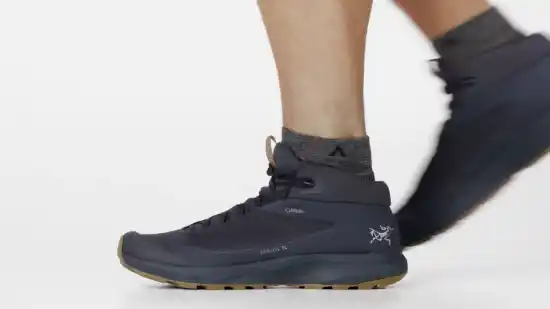
Wearing high socks with hiking boots can provide added protection and comfort. They prevent chafing and keep your legs warm. For example, Sarah hiked through the snowy mountains wearing high socks and experienced no discomfort or coldness in her lower legs.
Here are four reasons why you should consider wearing high socks with your hiking boots:
- Abrasion protection: High socks act as a barrier between your skin and the rough materials of your boots. They protect your shins and calves from painful abrasions.
- Warmth retention: When you’re hiking in colder climates or crossing glaciers, high socks can help insulate your lower legs. They keep them warm and prevent frostbite.
- Moisture wicking: High socks made from moisture-wicking materials can effectively pull sweat away from your skin. This reduces the chances of blisters and discomfort.
- Added support: High socks can provide extra support to your legs. They reduce muscle fatigue and prevent potential injuries.
Wading or Hiking: Choose the Perfect Boots for Outdoor Activities
You must consider your specific needs and activities when choosing between wading and hiking boots. While hiking boots can be used for wading, they may not provide the same level of protection and traction as dedicated wading boots.
If you’re an avid fisherman, investing in wading boots is essential for a comfortable and safe fishing experience. Wading boots may be more expensive than hiking boots due to their specialized features.
So, lace up your boots, cast your line, and enjoy the adventure of wading or hiking.

